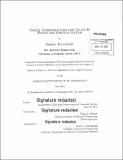| dc.contributor.advisor | Franz X. Kärtner | en_US |
| dc.contributor.author | Živanović, Goran | en_US |
| dc.contributor.other | Massachusetts Institute of Technology. Department of Electrical Engineering and Computer Science. | en_US |
| dc.date.accessioned | 2014-10-21T17:25:06Z | |
| dc.date.available | 2014-10-21T17:25:06Z | |
| dc.date.copyright | 2014 | en_US |
| dc.date.issued | 2014 | en_US |
| dc.identifier.uri | http://hdl.handle.net/1721.1/91083 | |
| dc.description | Thesis: S.M., Massachusetts Institute of Technology, Department of Electrical Engineering and Computer Science, 2014. | en_US |
| dc.description | 45 | en_US |
| dc.description | Cataloged from PDF version of thesis. | en_US |
| dc.description | Includes bibliographical references (pages 108-114). | en_US |
| dc.description.abstract | In integrated photonic circuits photodetector is one of key components, modern applications require that photodetector has a high 3 dB bandwidth. The ultimate limit for the response time for conventional photodetectors (like vertically illuminated photodiode, Schotky photodiode, MSM photodetector etc.) is given by the transit time of the photogenerated electron-hole pairs, it can not be minimised by decreasing the thickness of the depletion region without reducing quantum efficiency (i.e. the fraction of the incident light that is absorbed). Waveguide photodetectors have been developed to overcome this trade-off. In the waveguide photodetector light propagates in a direction that is parallel to the junction interfaces and is perpendicular to the drift of the generated electron-hole pairs. This geometry decouples absorption length from the drift length. Therefore the waveguide photodetector can have both a very thin active region for short transit time and a long absorption length for a high quantum efficiency. In this thesis , I designed germanium on silicon photodetector. The main designing tool was full vectorial 3D Finite Difference Time Domain (FDTD) simulator. Bandwidth-efficiency product was used as the main figure of merit. The input is silicon rib waveguide, which is optimised to maximize transmitted power. For optimal dimensions of the device calculated responsivity is 0.94 A/W, efficiency is 83 %, bandwidth is 64 GHz and bandwidth x efficiency product is 53 GHz. | en_US |
| dc.description.statementofresponsibility | by Goran Živanović. | en_US |
| dc.format.extent | 114 pages | en_US |
| dc.language.iso | eng | en_US |
| dc.publisher | Massachusetts Institute of Technology | en_US |
| dc.rights | M.I.T. theses are protected by copyright. They may be viewed from this source for any purpose, but reproduction or distribution in any format is prohibited without written permission. See provided URL for inquiries about permission. | en_US |
| dc.rights.uri | http://dspace.mit.edu/handle/1721.1/7582 | en_US |
| dc.subject | Electrical Engineering and Computer Science. | en_US |
| dc.title | Design considerations for Ge-on-Si waveguide photodetector | en_US |
| dc.type | Thesis | en_US |
| dc.description.degree | S.M. | en_US |
| dc.contributor.department | Massachusetts Institute of Technology. Department of Electrical Engineering and Computer Science | |
| dc.identifier.oclc | 892642760 | en_US |
